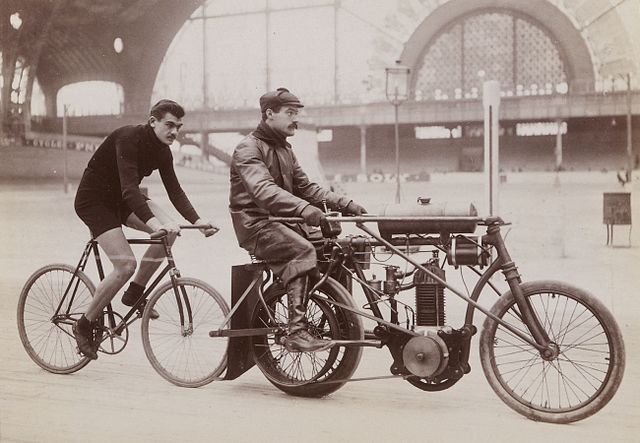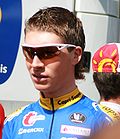Top Qs
Timeline
Chat
Perspective
List of racing cyclists and pacemakers with a cycling-related death
List of deaths of cyclists during competition or training From Wikipedia, the free encyclopedia
Remove ads
The first documented deaths of competitive cyclists during competition or training date to the 1890s and early 1900s when the recently invented safety bicycle made cycling more popular, both as a sport and as a mode of transport.[1] The athletes listed here were either professional cyclists, professional pacemakers or well-known competitive amateurs who had a cycling-related death, mostly during a race or during training. Pacemakers are motorcyclists utilized in motor-paced racing, riding motorcycles in front of their cycling teammates to provide additional speed to those cyclists via the resulting slipstream.[2]

site of Breton's 1902 death
(c. 1900 postcard)

Safety has been a concern since cycling's early days. By 1929, at least 47 people had died while racing at velodromes – 33 cyclists and 14 pacemakers.[3][Note 1] Motor-paced cycling still exists in the modern era as keirin racing and derny racing. A number of professionals and competitive amateurs have been killed in crashes with motorized vehicles while training on public roads plus there is a growing number of cyclists who have died of heart attacks while cycling in a race or while training.[6] Some of these deaths affect cycle racing afterwards – the death of Andrey Kivilev in a crash during the 2003 Paris–Nice race caused the Union Cycliste Internationale to institute a mandatory helmet rule.
The dangers of the various sporting forms of cycling continue to be an issue,[7] including training on public roadways.[8] A survey of 2008 Olympics teams, however, indicated that cycling was not even in the top six most injury-prone sports during competition that year.[9] Racing cyclists who have died during a race or during training are remembered by cycling aficionados and the cycling press. Their personal effects are exhibited in museums,[10] their cemetery markers and tombstones are visited by fans, and as one commentator wrote: "Plaques, statues and shrines to cycling's fallen heroes are scattered all over Europe's mountain roads, turning any ride into a pilgrimage."[11]
Remove ads
Cyclists who died during a race or because of a crash that happened during a race
Remove ads
Cyclists who died during training
Summarize
Perspective
The following athletes died while individually training for competitions or during scheduled breaks while participating in a professional race. The only incident of multiple deaths from a team involved Néstor Mora, Augusto Triana, and Hernán Patiño from Team Postobón in 1995. The death rates for cyclists, in general, differ from country to country depending on how popular cycling is. A 2015 study of European Union cyclists' deaths, for instance, showed that in the Netherlands almost 25% of road deaths were cyclists while Greece had less than 5%.[8][Note 24]
1900 to 1989
1990 to 2000
2001 to 2009
2010 to 2020
2021 to present
Remove ads
See also
- Bicycle racing
- Madonna del Ghisallo
- Ghost bike
- Ride of Silence
- List of doping cases in cycling
- Cycling track tragedy at Berlin - a tragic incident in which a motorized derny crashed into crowds.
Notes
- The total includes the professional pacemakers (14) and riders (33) but does not include injuries/deaths of bystanders. On page 101 Mangan recounts some details of the infamous 1909 Friedenau (Berlin) track accident with nine spectators being killed and 52 others injured.[4] Other sources refer to the July 18, 1909 disaster happening at the "Botanical Garden" track or Botanischer Garten track.[5]
- "Bert" Harris's given name was Albert Walter Allen Harris and he was nicknamed "Invincible Harris". The fastest short-distance rider in England, he was also the first Professional Cycling Champion of England and one of the most well-known athletes in his era.
- Some sources spell Oscar Aaronson's last name as "Aronson".
- The reference Sport-Album der Rad-Welt" was an annual compendium of the sports-newspaper Rad-Welt or "Bike World" which included a column, "Die Toten der Rennbahn" (or "The Dead of the Racetrack") that consisted of obituaries for dead cyclists.
- Some sources spell Käser's name as "Carl Kaeser" see "Trove"/The Sydney Mail reference.
- Piet van Nek Sr.'s name is also rendered in some sources as "Piet van Neck".
- Some sources spell the name as "Christiaan Orlemans".
- Pawlack is also rendered as "Georg Klein Bohrau Pawlack".
- When Walter Rutt (the former world champion) wrote to the "American Bicyclist and Motorcyclist (Volume 71)" published in 1950, he referred to this race not as the actual Six-Day Race but as a 'team race that was run before' it and that this team race was of a 'A Thousand Laps' (150 km) variety.[127]
- There were two Berlin Six-Days races run in 1951, one in March and one in December. Van Beek died while racing the March 1951 Berlin Six-Day and Rudi Mirke died during the December Six-Day. There is some confusion in sources about which race Mirke and van Beek died in. The Berlin official visitors bureau website, for instance, has the two men involved in the same fatal collision.[130]
- The circumstances surrounding Simpson's death were controversial. The autopsy report said that drugs (amphetamines) were found in his system but judged the overall cause of death as being a combination of heatstroke, oxygen depletion and physical exertion.[164] The temperature that day was 45 degrees Celsius/113 degrees Fahrenheit in the shade[165] – the heat combined with the exertion of getting up Ventoux plus riders' dehydration (since they were limited on water intake by Tour rules)[166][167] were all contributing factors.
- Sources refer to this cyclist as Manuel Galera and as Manuel Galera Magdaleno.
- Maneul's last name is also sometimes spelled as "Santiesteban".
- Espinosa is also known as "José Antonio Espinosa Hernandez".
- Some sources render this cyclist's name as Saúl Morales Corral.
- There is a 58-year gap in this List of the recorded deaths of cyclists during training – from 1936 to 1994 – because none have been found so far by the editors who have worked on this List.
- Taylor is also known as "Edouard-Henry Taylor".
Remove ads
References
External links
Wikiwand - on
Seamless Wikipedia browsing. On steroids.
Remove ads




































































